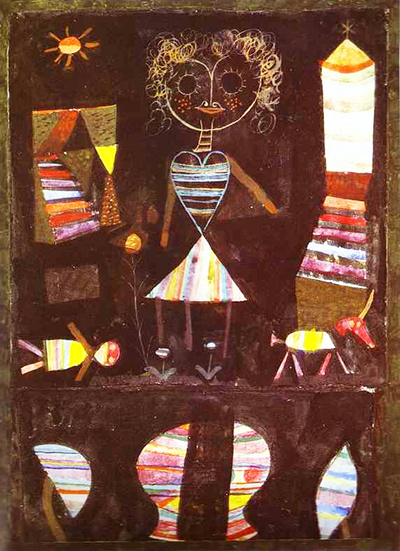Paul Klee, who had once toyed with the idea of becoming a sculptor, started making hand puppets for the ninth birthday of his son Felix.
He modelled eight in plaster and cloth, basing them on characters from Kasperl and Gretl, the German equivalent of Punch and Judy. These proved so popular with Felix that his father produced around fifty more between 1916 and 1925, fashioning some on political figures and a self-portrait.
Others became more experimental, displaying the artist's continuing interest in Surrealism.
Klee also constructed a theatre frame for Felix's plays, and in the water colour Puppet Theatre, the protagonists pop up again inside another kind of frame. The work was produced in 1923, when the artist was teaching at Germany's Bauhaus school, and his work leaned towards the abstract without completely forsaking recognisable forms.
It shows his characteristic love of colour, and his use of light and shadow. With Klee's habitual touch of irony, the puppets and props project a sense of movement and playfulness that conveys the feel of a theatre production. They move about like actors on a real stage, with Klee's typical picture language suggesting a narrative, and even a soundtrack from this life-long musician.
For later models, Paul Klee made use of imaginative components such as bristles, fur, hair, bones, nut shells, match boxes and electrical odds and ends. This was characteristic of the artist, who sometimes also used basic, simple materials in his art.
When Felix left home at 18, he took his favourite puppets with him, leaving his father with the ones made during the Bauhaus period. Most of the son's collection perished during wartime bombing raids on Wurzberg - ironically, just Dr Death survived.
Klee had become a member of the Blue Rider movement, who united to protest after the rejection of a work by the artist Kadinsky. They sought to champion modern art, and to pursue a more instinctive approach to painting.
Klee's first theatre for Felix was manufactured out of parts of the group's almanac, where subjects included folk, primitive and children’s art, and Egyptian puppets. These surely must have been in the artist's mind when he created his own characters, and when he produced his painting Puppet Theatre.




